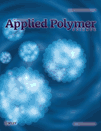Surface modification of contact lenses using adsorption of ethylene oxide branched copolymers
Abstract
To examine methods for reducing the amount of adsorbed protein on the surface of contact lenses during use, cationic copolymers containing poly(ethylene oxide) units were synthesized and evaluated as surface modifiers. Poly(ethylene oxide) graft-branched copolymers of composition 70 mol % dimethylaminoethyl methacrylate (DM) and 30 mol % methoxy polyethylene glycol methacrylate (Mp0G; p = 2, 4, 9; the average number of the ethylene oxide units) were obtained using nonionic monomers containing poly(ethylene oxide) units. The copolymers very efficiently prevented protein adsorption on a contact lens. Contact angle measurements showed that immersion in tear fluid made the lens surface hydrophobic because of adsorption of proteins with hydrophobic residues. The copolymer pretreatment made the lens surface hydrophilic, even after dipping in artificial tear fluid. These results suggest that adsorption of the poly(ethylene oxide) branched copolymer on the contact lens would make the lens surface hydrophilic and prevent protein adsorption. © 2012 Wiley Periodicals, Inc. J. Appl. Polym. Sci., 2013




